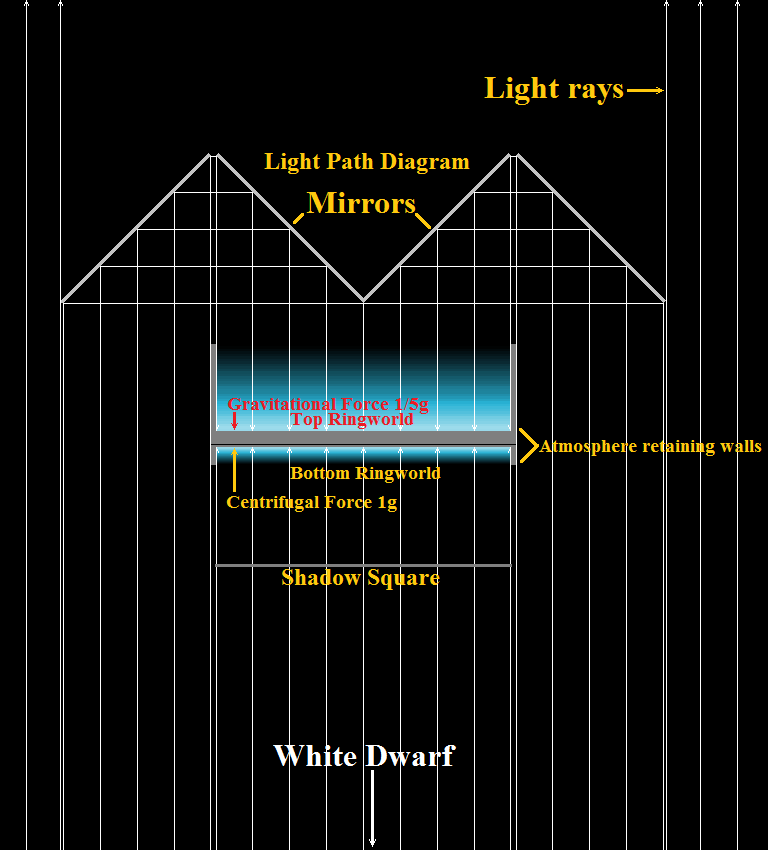New Mars Forums
You are not logged in.
- Topics: Active | Unanswered
Announcement
#1 2015-04-06 12:42:32
- Tom Kalbfus
- Banned
- Registered: 2006-08-16
- Posts: 4,401
Double-sided ringworld around Sirius B
One other possibility occurred to me with the talk of White Dwarf Dyson Spheres. how about a double-sided ring-world? This ringworld is a band 12,800 km wide and 8,000,000 km in radius centered on Sirius b, and it rotates fast enough to have 1-g on its inner surface and walls high enough to retain a breathable atmosphere. Inside the ringworld is a system of shadow squares which cast shadows on this ringworld for night and day. Every 40212.39 km long section of this ringworld has the surface area of the Earth since the circumference is 50,265,482.46 km, then 50,265,482.46 km / 40212.39 km = 1250 Earths worth of habitable surface area, but that's not all! You see the white dwarf provides something that ordinary stars do not have, that is significant gravity. At the habitable zone around Sirius b, the local gravity is 1/5th that on the Surface area of the Earth, so we place an outer ring that has 5 times the mass as the inner ring, so whatever the mass of the inner ring that rotates, the outer ring that does not rotate has 5 times that mass so it as an inward weight equal to the outward centrifugal force of the spinning ring world. To get light from the White Dwarf onto the outer surface of the non-rotating ring, we need a set of mirrors who's cross-section is the shape of an inverted 'W' This forms a ring outside the outer inhabited ring, it orbits the star, so it rotates, not as fast as the inner ring, but faster than the nonrotating outer ring. The wings of the 'W' reflect light from the white dwarf towards the middle 'V' of the "W' and the 'V' reflects that light back downward onto the surface of the nonrotating outer ring. this 'W' mirror is segmented, that is they can rotate parallel to the incoming light rays from the white dwarf and reflect none of the light back towards the outer ring surface, producing night, but when they assume a 45 degree angle, they turn that light around 180 degrees to shine on the outer ringworld. The gravity of the outer ringworld surface is 1/5th of earth's surface gravity which is due to the gravitational pull of the white dwarf itself. the Surface area of the outer ring is again 1250 times Earth's, except in this case the surface gravity is only 1/5th of a g instead of a full Earth's gravity. Now 2500 Earths worth of habitable space, half of them at 1/5th g I nothing to sneeze at either!
The tangential velocity of the ringworld would be 310 km per second to get 12 meters per second squared centripedal acceleration, the white dwarfs gravity reduces the feel of it to 10 meters per second squared at the inner surface and at the outer surface of the non-spinning ring, it produces a 2 meter per second squared inward acceleration due to gravity. The Mirrors above are in orbit which is at a velocity of 126.5 km/second for orbit. Rotation rates are 162,146.72 seconds (1.875 days) for the inner ring and 397355.59 seconds (4.6 days) for the orbiting mirror array.
Last edited by Tom Kalbfus (2015-04-06 12:54:16)
Offline
Like button can go here
#2 2015-04-07 08:18:42
- Tom Kalbfus
- Banned
- Registered: 2006-08-16
- Posts: 4,401
Re: Double-sided ringworld around Sirius B
Here is an illustration of a cross section of the ringworlds, that I think you will find helpful:
Surface area of top and bottom ringworlds is equal to 1250 Earths each, the bottom ring rotates around white dwarf once every 1.875 days at a velocity of 310 km/s providing acceleration of 1g away from the central star, the top ringworld doesn't rotate at all, and the acceleration due to gravity is at 0.2g towards the central star. Above the top ringworld is a ring array of mirrors at orbital velocity around the white dwarf (126.5 km/s) which rotates around the star once every 4.6 days, those mirrors reflect light from the white dwarf onto the upper ringworld surface. Below the bottom ringworld is a ring of shadow squares, the shadow squares block light from reaching the bottom ringworld surface intermittently to produce night, the upper mirror arrays have gaps in them which for periods of time do not reflect light onto the top ringworld producing night. Total surface area for both top and bottom ringworlds is equal to 2500 times Earth. 
This is your normal ring world that is 1 AU in radius around a normal sun, the structure for the inner ringworld is similar with shadow squares, only in my case I put the shadow squares up closer to the surface of the bottom ringworld.
this map could be used as part of the inner surface of the bottom Ringworld, it represents 1 Earth worth of surface area on this ringworld.
Last edited by Tom Kalbfus (2015-04-07 08:32:42)
Offline
Like button can go here